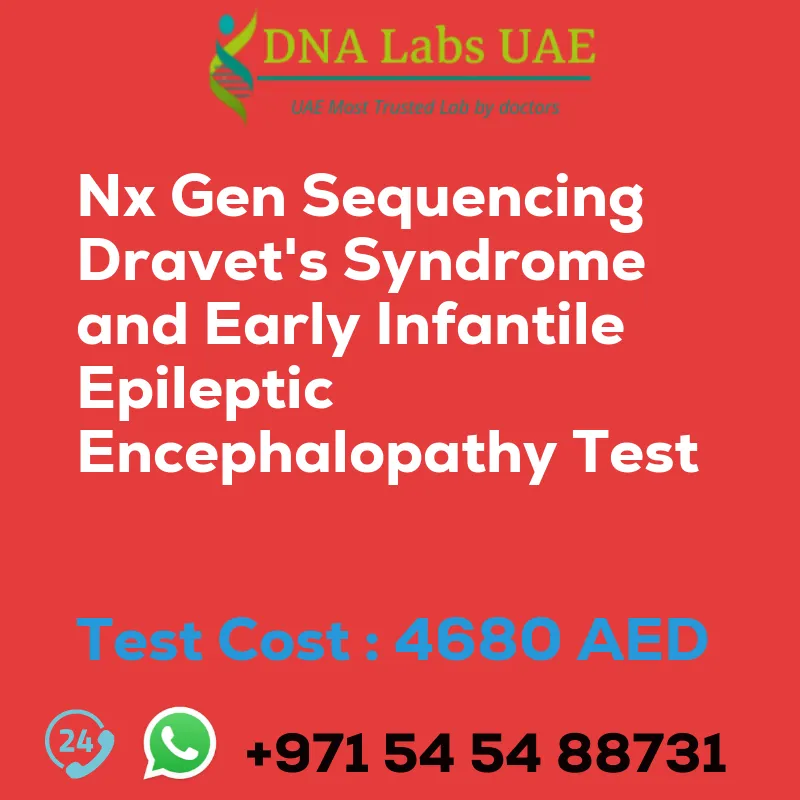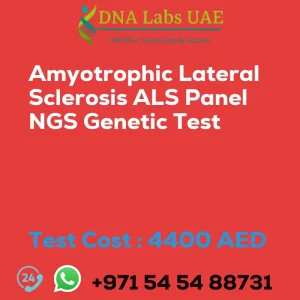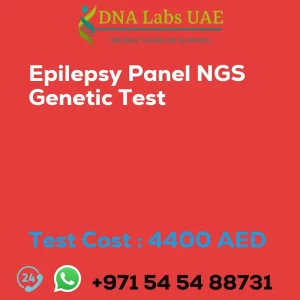Nx GEN SEQUENCING DRAVET’S SYNDROME and EARLY INFANTILE EPILEPTIC ENCEPHALOPATHY Test
At DNA Labs UAE, we offer the Nx GEN SEQUENCING DRAVET’S SYNDROME and EARLY INFANTILE EPILEPTIC ENCEPHALOPATHY Test. This test helps in the diagnosis of Dravet’s Syndrome and Early Infantile Epileptic Encephalopathy (EIEE), which are rare genetic disorders characterized by severe epilepsy and developmental delays.
The test components include ARHGEF9, ARX, CDKL5, GABRG2, KCNQ2, KCNT1, PCDH19, PNKP, PLCB1, SCN1A, SCN2A, SCN8A, SCN9A, SLC25A22, SPTAN1, and STXBP1. The cost of the test is AED 4680.0.
To conduct the test, we require a sample of 10 mL (minimum 5 mL) whole blood from 2 Lavender Top (EDTA) tubes. The sample should be submitted refrigerated and should not be frozen. Additionally, a duly filled Whole Exome Sequencing Consent Form (Form 37) is mandatory.
The report delivery time for this test is 40 working days, with the sample collected daily by 9 am.
The method used for this test is Next-generation sequencing (NGS) combined with Sanger sequencing. This test falls under the category of Genetic Disorders-Encephalopathy and is conducted by our Molecular Diagnostics department, under the supervision of a Neurologist.
Prior to the test, it is mandatory to fill the Whole Exome Sequencing Consent Form (Form 37).
Next-generation sequencing (NGS) is a powerful tool for the genetic testing of Dravet’s Syndrome and Early Infantile Epileptic Encephalopathy (EIEE). It allows for the simultaneous sequencing of multiple genes, enabling the identification of genetic mutations associated with these disorders.
There are two commonly used NGS approaches for these tests – Whole Exome Sequencing (WES) and targeted gene panel sequencing. WES involves sequencing all the protein-coding regions of the genome, while targeted gene panel sequencing focuses on specific genes known to be associated with Dravet’s Syndrome and EIEE. The choice between these approaches depends on the specific clinical presentation and suspected genetic cause.
By analyzing the patient’s DNA, NGS can identify mutations or variations in genes known to be associated with Dravet’s Syndrome and EIEE. These genetic findings are valuable for diagnosis, prognosis, and personalized treatment options.
NGS-based testing for Dravet’s Syndrome and EIEE has revolutionized the field of genetic diagnostics, enabling faster and more accurate identification of underlying genetic causes. This information is crucial for guiding clinical management, genetic counseling, and potentially identifying targeted therapies or clinical trials for affected individuals.
| Test Name | Nx GEN SEQUENCING DRAVET’S SYNDROME and EARLY INFANTILE EPILEPTIC ENCEPHALOPATHY Test |
|---|---|
| Components | ARHGEF9, ARX, CDKL5, GABRG2, KCNQ2, KCNT1, PCDH19, PNKP,PLCB1, SCN1A, SCN2A, SCN8A, SCN9A, SLC25A22, SPTAN1, STXBP1 |
| Price | 4680.0 AED |
| Sample Condition | Submit 10 mL (5 mL min.) whole blood from 2 Lavender Top (EDTA) tubes. Ship refrigerated. DO NOT FREEZE. Duly filled Whole Exome Sequencing Consent Form (Form 37) is mandatory. |
| Report Delivery | Sample Daily by 9 am; Report 40 Working days |
| Method | NGS, Sanger sequencing |
| Test type | Genetic Disorders-Encephalopathy |
| Doctor | Neurologist |
| Test Department: | MOLECULAR DIAGNOSTICS |
| Pre Test Information | Duly filled Whole Exome Sequencing Consent Form (Form 37) is mandatory. |
| Test Details |
Next-generation sequencing (NGS) can be used for the genetic testing of Dravet’s Syndrome and Early Infantile Epileptic Encephalopathy (EIEE). These are both rare genetic disorders characterized by severe epilepsy and developmental delays. NGS allows for the simultaneous sequencing of multiple genes, making it a powerful tool for identifying genetic mutations associated with these disorders. Whole exome sequencing (WES) and targeted gene panel sequencing are commonly used NGS approaches for these tests. WES involves sequencing all the protein-coding regions of the genome, while targeted gene panel sequencing focuses on specific genes known to be associated with Dravet’s Syndrome and EIEE. The choice between these approaches depends on the specific clinical presentation and suspected genetic cause. By analyzing the patient’s DNA, NGS can identify mutations or variations in genes known to be associated with Dravet’s Syndrome and EIEE. These genetic findings can provide valuable information for diagnosis, prognosis, and personalized treatment options. NGS-based testing for Dravet’s Syndrome and EIEE has revolutionized the field of genetic diagnostics, enabling faster and more accurate identification of underlying genetic causes. This information is crucial for guiding clinical management, genetic counseling, and potentially identifying targeted therapies or clinical trials for affected individuals. |








